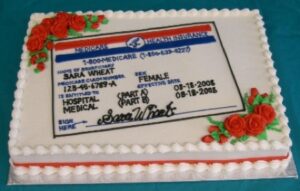The Part B Medicare deductible for 2013 is $147.00.

What should you do with this information? You should avoid taking a big financial hit in the first quarter of 2013 by collecting deductibles at time of service. How do you do that?
- Let all patients know in advance that you collect deductibles by making it part of your communication with them. Put it in your financial policy (get a copy of my preferred financial policy below), put it on your website, and let patients know when you schedule their appointment, or make an appointment reminder with verbiage like:
“We look forward to seeing you at your appointment. Please bring your insurance cards and all medications to your visit. We will collect your co-pay, your deductible, and any co-insurance required by your insurance plan.”
- Explain what a deductible is. Get my sample patient handout explaining deductibles below.
- Train front desk staff on deductibles and get them comfortable discussing deductibles with patients and answering their questions.
- Do not collect deductibles for Medicare patients who also have Medicaid, or for Medicare patients with supplemental insurance as there most likely will not be a balance that the patient will owe.
- It is ideal to use a Credit Card On File program to charge the patient’s credit card at time of service, or when the EOB (Explanation of Benefits) arrives in 15 days.
Other important Medicare numbers for 2013
Part A: Hospital Insurance Premium for 2013– $441.00 per month. Most 65+ patients get Part A for free if they already receive retirement benefits from Social Security or Railroad Retirement due to taxes paid during working years. Part A includes coverage for:
- Inpatient care in hospitals
- Skilled nursing facility care
- Hospice care
- Home health care – skilled nursing care, physical therapy, occupational therapy, speech therapy, medical social services, dietary and home health aides (100% covered with no co-pay) for homebound patients after a 3-day hospital stay
Part B: Medical Insurance Premium for 2013 – $104.90 per month for most, but not all patients. Some patients automatically get Part B, others may have to pay more based on their IRS tax return from 2011. Part B includes coverage for:
- Services from doctors and other health care providers
- Outpatient care (includes emergency room and observation services for physician charges)
- Home health care – services provided to a homebound patient when the patient has not been hospitalized for 3 days prior to need
- Durable medical equipment
- Some preventive services
Part C: Medicare Advantage Plans – also called a Medicare Replacement Plan because it replaces traditional or original Medicare with a plan offered by a Medicare-approved private insurance company (BCBS, UHC, etc.) Premiums vary with individual Medicare Advantage Plans. Medicare Advantage Plans:
- Include all benefits and services covered under Part A and Part B
- Usually include Medicare prescription drug coverage (Part D) as part of the plan
- May include extra benefits and services for an extra cost
- Cannot be used in combination with a Medigap policy
Part D: Medicare Drug Coverage for 2013 – monthly premiums will vary based on income, and whether or not Part D is included if the patient opts for Part C coverage. Some plans have deductibles and some do not. Most drug plans have a coverage gap referred to as the “donut hole”, which means coverage is temporarily limited after the patient and drug plan have spent a certain amount for covered drugs. In 2013, once the patient reaches the donut hole, they pay 47.5% of the plan’s cost for covered name-brand drugs and 79% of the plan’s cost for covered generic drugs until the end of the donut hole is reached. In every successive year after 2013, the donut hole will shrink until 2020 when the donut hole will cease to exist.
Medicare Supplement Insurance (also called Medigap) – Policies are sold by private insurance companies and help pay some of the health care costs that Medicare doesn’t cover. Patients have a one-time 6-month Medigap Open Enrollment Period which starts the first month they are 65 and enrolled in Part B. This period gives patients a guaranteed right to buy any Medigap policy sold in their state regardless of their health status.
Click here to receive a free copy of a financial policy and a patient handout explaining deductibles.


